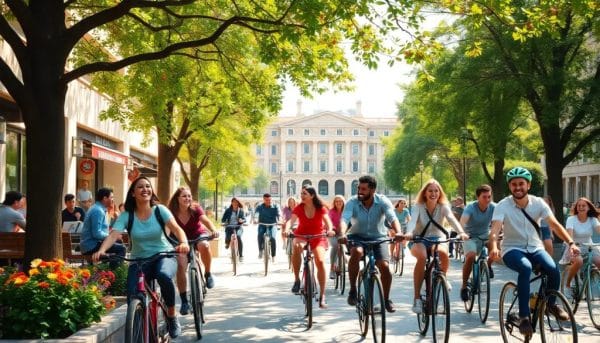Cycling has become a popular mode of transportation, particularly among university students. With the rise of bike-friendly cities, more students are opting for cycling as their primary commuting method. This shift is not only economical but also supports a healthier lifestyle.
In this article, we will explore the best student-friendly cities for cycling, how universities support cycling initiatives, and the overall impact of cycling on student life.
What makes a city bike-friendly for students?
A city that caters to the needs of student cyclists typically features a well-developed cycling infrastructure. This includes extensive bike lanes, secure bike parking, and easy access to public transport. Cities like Davis, California and Boulder, Colorado are great examples, as they have integrated cycling into their urban design.
Moreover, community engagement is crucial. Events such as bike maintenance workshops and group rides not only encourage cycling but also foster a sense of belonging among students. A welcoming environment plays a significant role in motivating students to choose cycling over other forms of transport.
Additionally, safety is a major concern for cyclists. Cities that invest in safe cycling networks, traffic calming measures, and education programs for both cyclists and drivers tend to be more appealing to student cyclists. This enhances not only the cycling experience but also the overall safety of the environment.
Which universities support cycling initiatives?
Many universities recognize the importance of promoting cycling among their students. For instance, the University of Edinburgh has been recognized as one of the top institutions in the UK for supporting student cyclists. They provide bike storage, maintenance facilities, and regular safety campaigns aimed at encouraging cycling.
Other notable universities include Bristol, Glasgow, and Manchester. Each of these institutions has implemented various initiatives such as bike-sharing schemes and organized cycling events. Such programs not only enhance student engagement but also contribute to a healthier campus environment.
- Bike maintenance events
- Secure bike parking facilities
- Discounted bike rental schemes
By investing in cycling infrastructure and resources, universities can help students overcome the challenges associated with commuting, aligning with broader environmental goals.
How does cycling improve student life?
Cycling offers numerous benefits that enhance student well-being. Firstly, it serves as a form of low-impact exercise, contributing to better cardiovascular health. Students who cycle regularly often report feeling more energetic and less stressed, improving their overall academic performance.
Additionally, cycling fosters social connections. Group rides and cycling clubs allow students to meet new people and form friendships, enriching their university experience. This social aspect of cycling cannot be overlooked, as it plays a vital role in building community.
Moreover, the economic advantages of cycling are significant. Students save money on transportation costs, making cycling an affordable commuting option. With the rising expenses associated with university, this financial relief can be crucial.
What are the benefits of cycling in university cities?
Cycling contributes to a more sustainable urban environment. Cities that promote cycling often experience reduced traffic congestion and lower carbon emissions. This aligns with global initiatives like World Bicycle Day, which advocate for sustainable transportation methods.
Furthermore, cycling enhances urban mobility. Students can navigate their campuses and surrounding areas more efficiently, allowing them to attend classes, meet friends, or enjoy leisure activities with ease. Cities that prioritize cycling also tend to be more vibrant and livable.
- Improved physical health
- Enhanced mental well-being
- Cost savings on transportation
- Reduced environmental impact
Ultimately, cities that embrace cycling not only benefit their residents but also attract more students, creating a dynamic and engaging atmosphere.
What are the top bike-friendly cities for students?
Several cities worldwide are renowned for their bike-friendly environments, catering specifically to students. Amsterdam, Netherlands, is often cited as the pinnacle of cycling culture, with extensive bike lanes and an integrated cycling infrastructure that makes commuting effortless.
Other noteworthy cities include Copenhagen, Denmark, which has created a robust cycling network, and Ann Arbor, Michigan, known for its cycling initiatives. These cities prioritize accessibility and convenience, making them ideal locations for student cyclists.
- Seattle, Washington - Emphasizes bike lanes and community cycling events
- Portland, Oregon - Offers a variety of bike-sharing programs
- Corvallis, Oregon - Recognized for its bike-friendly policies
Each of these cities showcases how effective urban planning can foster a thriving cycling culture, benefiting students and residents alike.
How can universities enhance cycling infrastructure?
To promote cycling, universities can invest in comprehensive infrastructure improvements. This includes building more bike lanes, providing secure bike parking, and implementing bike-sharing programs. Such initiatives can significantly enhance the cycling experience for students.
Moreover, universities can establish partnerships with local governments to advocate for better cycling policies and infrastructure. Collaborating with community organizations can lead to successful initiatives that benefit both students and local residents.
Educational programs on bike safety and maintenance can also be invaluable. By organizing workshops and training sessions, universities can equip students with the knowledge they need to cycle safely and confidently, ensuring a positive cycling experience.
What challenges do student cyclists face in urban areas?
Despite the numerous benefits of cycling, student cyclists often encounter challenges in urban environments. One significant issue is bike theft, which remains a concern in many college towns. Universities must take proactive measures to enhance security and educate students on proper bike locking techniques.
Additionally, navigating busy streets can be daunting for student cyclists. Poorly designed bike lanes and a lack of infrastructure can create unsafe conditions, deterring students from cycling. It is crucial for cities to invest in creating dedicated lanes and safety measures.
Lastly, adverse weather conditions can impact cycling frequency. Universities should consider providing resources such as sheltered bike storage and weather-related tips to help students remain committed to cycling, regardless of the weather.
Related questions about cycling around universities
What is the 75 rule in cycling?
The "75 rule" in cycling refers to the idea that a cyclist should maintain a speed of 75% of their maximum effort for an extended period. This strategy is beneficial for endurance training, allowing cyclists to improve their stamina while maintaining a sustainable pace.
What is the rule 67 for cycling?
The "67 rule" suggests that cyclists should aim to ride at least 67% of the time at a moderate intensity. This balance of intensity helps build a solid cycling foundation, making it easier to push harder during more intense rides.
Which city in the UK is most cycling friendly?
According to various studies, Bristol is often cited as one of the most cycling-friendly cities in the UK. The city has made significant investments in cycling infrastructure, including dedicated bike lanes and numerous community cycling initiatives.
Which European city is considered to be the most bicycle-friendly in the world?
When it comes to Europe, Amsterdam consistently ranks as the most bicycle-friendly city globally. Known for its extensive cycling network, Amsterdam promotes a culture of cycling that is deeply ingrained in the daily lives of its residents.


Leave a Reply